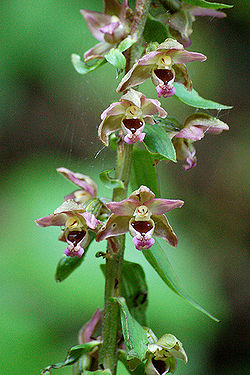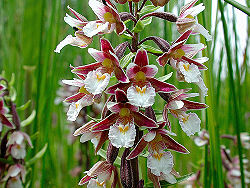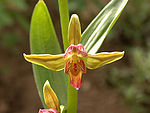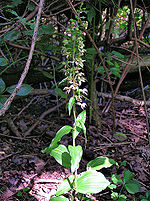Helleborine
| Helleborine |
|---|

|
| Scientific Classification |
|
| Species |
|
| Epipactis palustris |
Helleborine is the common name for several species of orchids that belong to the taxonomic genus Epipactis. They usually grow between one to three feet in height and grow in a variety of habitats in Europe, North America and Asia. This orchid is native to Europe but has become an invasive species to America.
Anatomy
The helleborine plant usually grows between one and three feet in height. The size of the flower varies between 1/2 of an inch and 3/4 of an inch and is usually green, blended with lavender. [1]
Often times, multiple stems may emerge from a single rootstock. The sepals grow between 1 and 1 1/2 cm in length and the petals grow to about the same length and have almost the same appearance as the sepals. [2]
Epipactis are dependant on a mycorrhizal symbiosis, a characteristic of all orchids. As a result of this, some species have reduced leaves and require only small amounts of chlorophyll. Epipactis viridiflora even has the ability to grow with the complete absence of chlorophyll, creating purple leaves as opposed to violet leaves. [3]
Reproduction
The helleborine flowers between the months of July and August. In Europe, it's native habitat, it is pollinated by wasps. [4]
These orchids are classified as deciduous. They are also perennials which means they survive and bloom year after year. [5]
The orchid has a single, stalkless anther which is attached to the top of the column. The hinged terminal portion of the lip causes insects to fly upward as it exits the orchids blossom. By doing this, it rubs the rostellum collecting a sticky fluid which cements the pollen to the insect. It's most common pollinators are honey bees, flies, wasps, etc. [6]
It also reproduces vegetatively via its long rhizomes, or root structures. They creep along underneath the soil and have long spikes of flowers that shoot up as they travel along. One helleborine plant has the ability to cover a large area of habitat with its flowers. [7]
Ecology
Helleborine originated in Europe and is most commonly found in woodsy habitats. [8] They thrive in subtropical or moist climates in places such as America, Asia and Europe.
There is only one species of helleborine that originated in America which is the Giant Helleborine (E. gigantea). This species is also the only orchid with the ability to survive in a flooded habitat. There are other species that are found in the U.S. but they are not native to the area. However, there are invasive species from Europe that grow in the U.S. including the Broad-leaved Helleborine (E. helleborine).
This species is able to thrive in a very wide variety of habitats. [9] The habitat in which helleborine thrive best in are usually wet environments near the sides of marshes or bogs. Helleborine also grows well in peat-enriched soil. [10]
History
Helleborine, or epipactis, is a native orchid to Europe. There is one species of Helleborine (E. gigantea) which is native to North America. However, the rest of the species, especially the Epipactis Helleborine, or Broad-leaved Helleborine, have become an invasive species to America. [11]
Gallery
References
- Helleborine Connecticut Botanical Society. 11.13.05
- Epipactis helleborine Crantz
- Epipactis Gigantea Las Palitas Nursery
- Epipactis Multiple Authors, 3.31.09
- Epipactis Helleborine Unknown Author
- Marsh Helleborine Peter Burford, 7.16.2001





